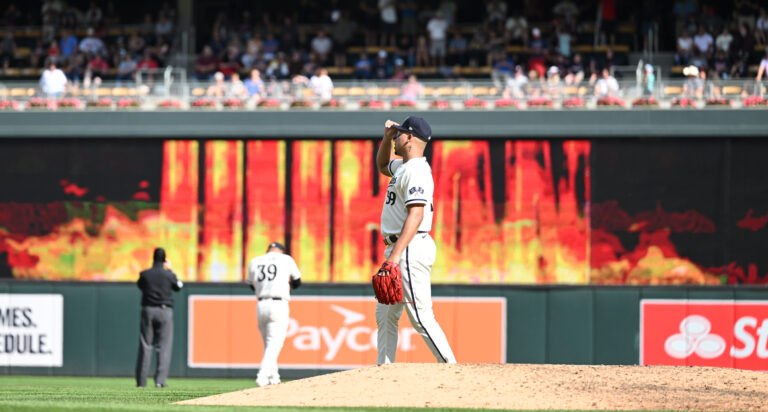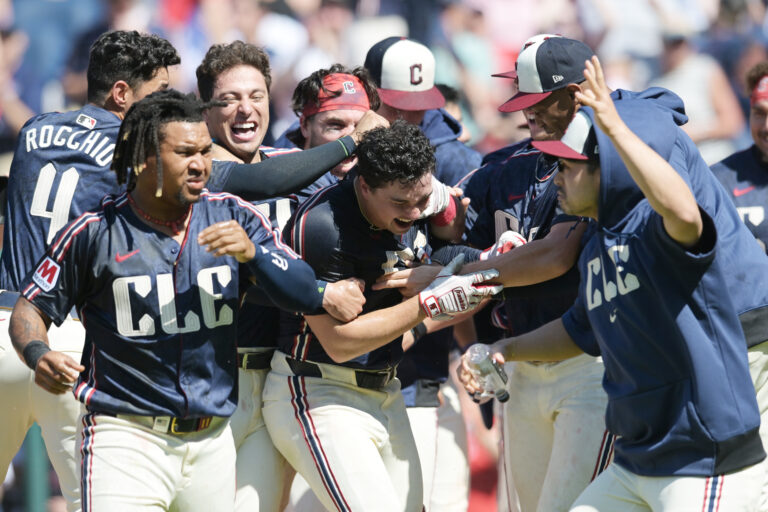
This past weekend, the Minnesota Twins were swept on the road by the division-leading Cleveland Guardians. In Sunday’s 5-2 loss, it was Twins closer Jhoan Duran that gave up the deciding blow, a three-run homer to outfielder Will Brennan after Minnesota had intentionally walked Naylor.
Following the walk, Duran was visited by the pitching coach, and apparently implored to throw a curveball to Brennan. That was the pitch that ended the game.
Duran told reporters after the game, “This time, it’s not my decision. I thought [Brennan] wasn’t good with fastballs. I’m an employee here, so whatever I need to throw, I need to throw it.”
Fastball or Curve, that is the question for Jhoan Duran
That’s quite a statement to make. It also brings into question a bit of strategy. If the front office/analytics team are saying that a curveball is the best pitch for this situation, but the pitcher (not just Duran, but any pitcher) thinks another something else would be better, then you tell me which is the right call?
In light of Jhoan Duran giving up walk-off HR on Curveball vs. Fastball (analytics-based decision making), @AlLeiter22 on traditional mentality of pitcher pitching to their strengths, not a hitter's weaknesses. #shegone pic.twitter.com/CUyc2GIFSz
— Tony Wuench (@twuench) May 21, 2024
Let’s take a look at the specific pitch that Duran threw and whether a fastball may have been a better option the other night.
With runners at first and second, Duran was asked to throw the curve to Brennan. It was the first pitch of the at-bat, and it was also the first pitch since he’d thrown one all the way to the backstop that advanced the runner on first to second and ultimately led to the intentional walk.
This season, Duran has been mixing his pitches more, throwing his four-seamer, curve, and splitter nearly identical amounts. He velocity is also down about a tick on all three. This season, the curve has been averaging 2,601 rpm, but the one that he threw was down a little at 2,525.

Not a huge difference, but it could mean that he didn’t put his absolute everything into this certain curveball, especially when you take into account that the two other hooks he threw were above his season average at 2,666 and 2,615 rpm.
The vertical break was in line with his seasonal average at 44 inches of drop. And while his two inches of horizontal movement were less than what he’s produced in 2024 (3.2 inches), the other two curves on this day had one and two inches of movement themselves, so maybe it was how he was throwing it on Sunday.
The big difference between the one that Brennan took out and the other two on the afternoon was about three miles per hour. The game-ender was thrown at 83.6 mph, while the other two hit 86.6 and 87.3 mph. His average on the year is 86.5, so 83 mph is a big drop.
Cleveland Guardians’ Will Brennan vs fastballs/curveballs

Last year, Duran was averaging 101.8 mph on his heater and he had a batting average against (BAA) of .213, which was right in line with his xBA of .218. This year, the fastball has given him more issues.
Yes, it’s down a tick, but batters are hitting .300 against it in the early going, and the xBA doesn’t provide hope for a quick turnaround at .287. So the fastball hasn’t been as effective, overall. His curveball has a BAA of .250 with an xBA of .112.
Brennan is a guy that doesn’t swing and miss (84th percentile) and doesn’t strike out (93rd percentile). He also doesn’t walk a ton, so he’s going to go up there, and he’s likely to make contact. This season, he’s hitting .217 against heaters with a .278 xBA, an 88.7 mph exit velocity, and a 17% whiff rate.
Against the curve he’s hitting .184 with a .227 xBA, an 88.5 mph exit velo, and an 18.2% whiff rate. With the exit velocities and whiff rate fairly similar, the difference in batting average, and expected batting average, comes into focus here. The Twins coaching staff appears to have been right in this instance.
Duran’s – not the Minnesota Twins – big mistake
The one saving grace for Duran here is that the location of the curveball, down and in to the left-hander, was in the exact right spot. That is an area that Brennan has a 43% whiff rate overall, and his swing tends to be a little longer when trying to get to balls in that part of the zone.
On the other side of that coin, Brennan’s highest exit velocity also comes from that exact spot, so when he hits one, he usually connects. His 99 mph exit velo, down and in, is why MLB broadcasts always say, ‘that’s exactly where lefties like to be pitched’.
In the end, the pitch selection doesn’t appear to have been the worst, but the execution may have been at fault here. It also doesn’t help that the conversation with the pitching coach appears to have been one-sided, so if Duran had any objections, they were not heard.
More must-reads:
- Astros scratch Justin Verlander as nightmare season continues
- Three Padres prospects who should be untouchable in trade talks
- The 'MLB rookie pitchers with the most strikeouts' quiz
Breaking News
Customize Your Newsletter
 +
+
Get the latest news and rumors, customized to your favorite sports and teams. Emailed daily. Always free!

